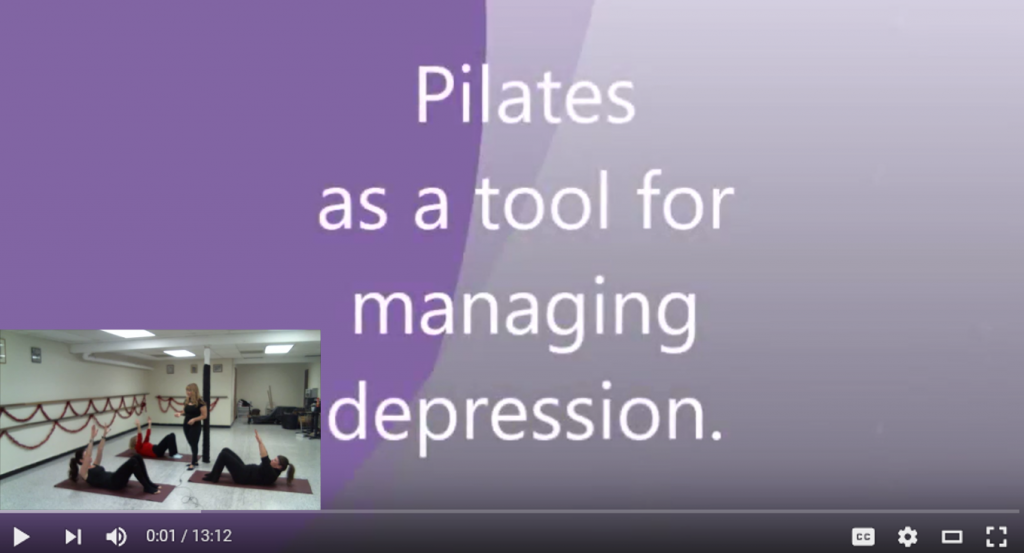The Truth about Pilates and Depression – by Laurette Ryan
Each day I am thankful for Pilates, for myself and countless others I know, for whom Pilates is a lifeline.
I am a teacher of wellness and health – a Pilates teacher. 1 in 4 people can say “I have depression today or have had depression at some time in my life” – I am one of those people. Depression is a very real, physical condition, like diabetes or heart disease. If your heart doesn’t function correctly, acquaintances are concerned and sympathetic, but if your brain has a glitch or two, you generally do not get the same level of understanding.
Here are some thoughts from Dr. Heidi Peddell Hall, a Massachusetts-based Clinical Psychologist, on depression as a disease:
The DSM-V, which is created by the American Psychiatric Association, uses the “medical model” for diagnosing mental disorders. The problem with this is that mental disorders, such as depression or anxiety, are not as concrete and clear cut in etiology and treatment as physical disorders, such as diabetes, heart disease or pneumonia. People’s emotions and behaviors appear to be related to factors that are both physical (e.g. genes, biochemicals, hormones, medical conditions) and environmental (e.g. factors related to parenting, early peer interactions, experiences of success or failure, psychological trauma, loss of a loved one, home or job). In addition, each person is born with their own individual temperament, which often determines how they will naturally tend to cope with stressful situations.
Depression is often called a mental illness. That makes many people nervous. If we started calling it what it is (a brain disease), society might begin to view it differently. You wouldn’t tell someone with depression to just “snap out of it” or “cheer up” (do you tell someone with diabetes to just “snap out” of their insulin imbalance?). Depression is, in part, a misfiring of the circuits in the brain. Researchers are making exciting breakthroughs, particularly regarding neuroplasticity – the ability of the brain to “rewire” itself by increasing, decreasing, or modifying neural connections. I believe that mindful Pilates training promotes neuroplasticity.
Factors that may put you at higher risk for depression include heredity, environment, and illness. One genetic factor is your serotonin transporter gene. Long serotonin transporters give you more access to serotonin which is a feel-good optimistic chemical. If you were born with genes for short serotonin transporters, being optimistic is not something that comes easily.
Another factor is environment. Live in a happy place with happy people … your genetic weaknesses may never trigger. Be exposed to a harsh, abusive existence with even a minor genetic weakness, you may experience depression.
Nature? Nurture? Probably a little of both. Throw in, for good measure, the evolution of the modern brain and it’s easy to see that our fast-paced modern day world is a little tough on our most precious organ. Your neocortex is the most recently evolved part of the brain. This is where you develop self-control and planning. If it is used regularly, it grows strong connections (neural pathways) and can inform the “fight or flight” (more primitive part) of your brain when there is no real life threatening emergency. By strengthening the neocortex, you regain control. Fears from the past are recognized as in the past. Worry about the future is seen as an opportunity to plan for the best possible outcome.
The neocortex also houses the language center. When we are filled up with toxic stress chemicals, and we say negative things about ourselves, our mind believes it is true regardless of whether it is actually true. By strengthening the neural connections to the anterior cingulate cortex (think of this like pressing harder on the brakes on a car), we can dramatically decrease the negative self-talk loop that plays such a powerful role in depression.

Check out Laurette’s Youtube vid ‘Pilates and Depression’
Creating stronger, denser, better pathways in the higher brain is accomplished through mindful movement. This is different than the “relaxation response” which can be beneficial in reducing stress hormones. Mindful movement is a controlled and concentrated intensive exercise or activity in which the participant is fully engaged with mind and body. The participant is thoughtfully invested in each moment.
Pilates exercise done in this way can be a great tool in dealing with and managing depression. Joseph Pilates wrote,
When brain cells are developed, the mind too is developed. Teachers start with sense organs. Contrology begins with mind control over muscles. By reawakening thousands and thousands of otherwise ordinarily dormant muscle cells, Contrology correspondingly reawakens thousands and thousands of dormant brain cells, thus activating new areas and stimulating further the functioning of the mind. No wonder then that so many persons express such great surprise following their initial experience with Contrology exercises caused by their realization of the resulting sensation of “uplift.”
The practice of Pilates is not just “doing exercises” but should be viewed as “being exercises.” If we perform these exercises properly with complete control, attention and concentration, we are training the brain, much in the same way as we train our muscles. We grow the attention center which helps to anchor the participant in their body, in the present, stopping the negative self-talk loop and strengthening the nervous system to handle stress.
By talking openly about depression, we can move ahead in finding solutions and tools for those who suffer. As society’s understanding increases, the support we provide for those suffering cancer, diabetes or heart disease, will become more available for those suffering depression.
Some Pilates-based tips for depression:
1. Be aware of using your entire body during every exercise. Every exercise begins first in the brain and travels instantaneously to the center, your core, to begin initiation. Each muscle is at the ready, but not in an overly tensed manner. Even difficult exercises should be practiced to achieve this connection.
2. Focus on creating a seamless rhythm between movement and breath. Connect each inhale or exhale to a specific direction of movement … let the breath fill or last the entire movement.
3. Have a “one exercise” rule! If depression has you in its grip – do one exercise. Commit to yourself that you will do one exercise, even if it’s in your bed! If you feel like you can do a second exercise, then go for it! And if not, focus on the one you did – use that as your lifeline.
Disclaimer: The information in this article is intended for educational purposes only. It does not constitute medical advice, nor is it a substitute for medical advice. You should consult a physician regarding medical diagnosis or treatment.
 Laurette Ryan PMA-CPT, Owner of Balancepoint Pilates Teacher Training with satellite programs in Massachusetts and North Carolina since 1999. President of Balancepoint Movement Mentors / Balancepoint Online. Laurette is a national fitness presenter, CEC provider for PMA, AFAA and NASM and has taught movement classes and provided continuing education for fitness professionals for over 35 years. Laurette started teaching dance and fitness at age 15. Attending the Boston Conservatory of Dance in 1980, where she was first exposed to the Pilates Method. In 1993 she developed the “Dancer Workout” a Pilates-based exercise class.
Laurette Ryan PMA-CPT, Owner of Balancepoint Pilates Teacher Training with satellite programs in Massachusetts and North Carolina since 1999. President of Balancepoint Movement Mentors / Balancepoint Online. Laurette is a national fitness presenter, CEC provider for PMA, AFAA and NASM and has taught movement classes and provided continuing education for fitness professionals for over 35 years. Laurette started teaching dance and fitness at age 15. Attending the Boston Conservatory of Dance in 1980, where she was first exposed to the Pilates Method. In 1993 she developed the “Dancer Workout” a Pilates-based exercise class.Author of “Basic Cuing for Pilates Teachers”, “Ready for Pilates for Everybody”, “The Professional Pilates Teachers Handbook”. She enjoys writing articles on Pilates and fitness, originator of www.pilatesworkoutblog.com. Rockstar Mat Teacher- Online course developer- balancepoint-online.teachable.
Laurette is a mother of 4 awesome pre-adults living in Massachusetts, who plans on teaching healthy movement till age 100 and has 2 major goals for the coming year-# 1. to mentor as many new upcoming talented teachers as she can and #2 to spread validated education about depression and anxiety -to eradicate the stigma and show how we can use movement as a tool of self-care.

